Thermal Energy Storage for Ethanol production: Cost-efficient and easy electrification
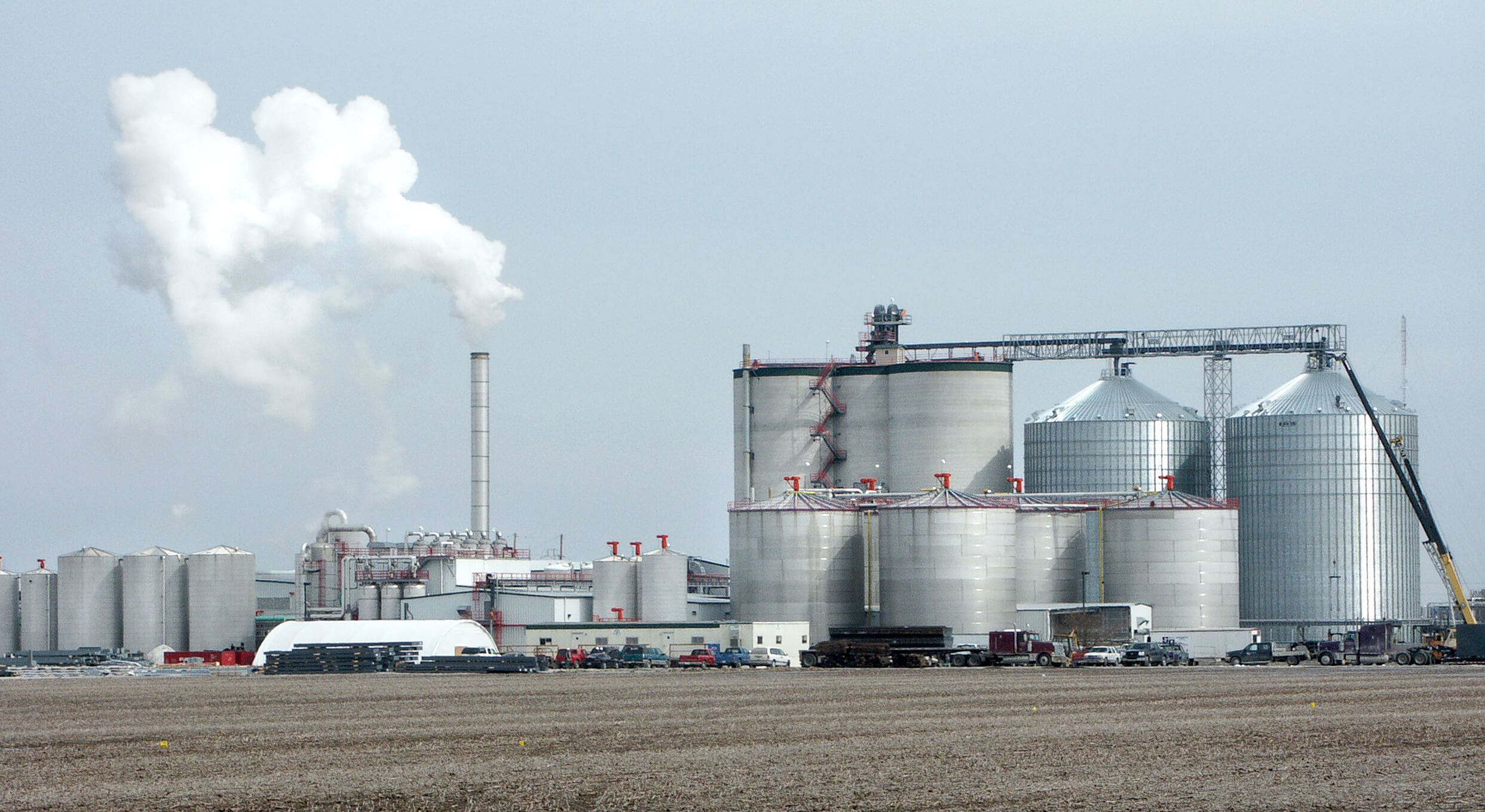
Producing ethanol for alcoholic beverages is one of the most energy intensive sectors in the food industry. Large steam networks supply the factories that are fermenting grains and fruits to ethanol. The process takes a lot of energy, usually fired by fossil fuels and thus also contributing to the large emissions of the food and beverage sector. Overall, the ethanol production for food is only a small fraction of the complete production, as over 80% of the production is for fuels as you can read in this article for the fuel production. It is necessary however to decarbonise the food segment of ethanol as well and luckily, it is not too complicated and economically feasible with Kraftblock.
Overview of decarbonizing steam in ethanol production
The basis for energy use in ethanol production is steam. In large facilities, steam networks operating at 180 °C or higher are used to supply distillation columns. The distilleries sector is the most energy-intensive in beverage ethanol production.
Steam can easily be electrified. Using Kraftblock’s Thermal Storage system instead of an e-boiler means that electricity can be purchased at low prices and used throughout the day. The unfixed ratio of charging/discharging and storage capacity of TES means that only a few hours are needed to cover the rest of the day. Adding grid services using the storage makes the business case even more beneficial. This model is employed in the Volt project, where Kraftblock replaces a gas boiler for frying potato crisps.
How is ethanol in the beverage industry is produced
Ethanol for beverages is produced through fermentation, a process where yeast converts sugars into ethanol and carbon dioxide. This process, used for millennia in beverages like wine and beer, involves a series of complex biochemical reactions.1
The production of ethanol for beverages involves several key steps: It begins with obtaining fermentable sugars, which can be extracted from various sources like sugarcane, corn, or other starch rich materials. These sugars are then fermented by yeast, converting them into ethanol and carbon dioxide. Finally, the ethanol is purified, typically through distillation, to achieve the desired concentration for beverages.2
Process steps in ethanol production:
- Sourcing feedstock: Grains (barley, corn, wheat), grapes, sugarcane, fruit.
- Mashing (for grains): Convert starches (sugars via enzymes)
- Fermentation: Yeasts convert sugars to ethanol.
- Distillation (for spirits): Concentrates ethanol (up to 95% purity).
- Aging/finishing (for some beverages): Maturing in barrels or blending.
- Bottling and distribution
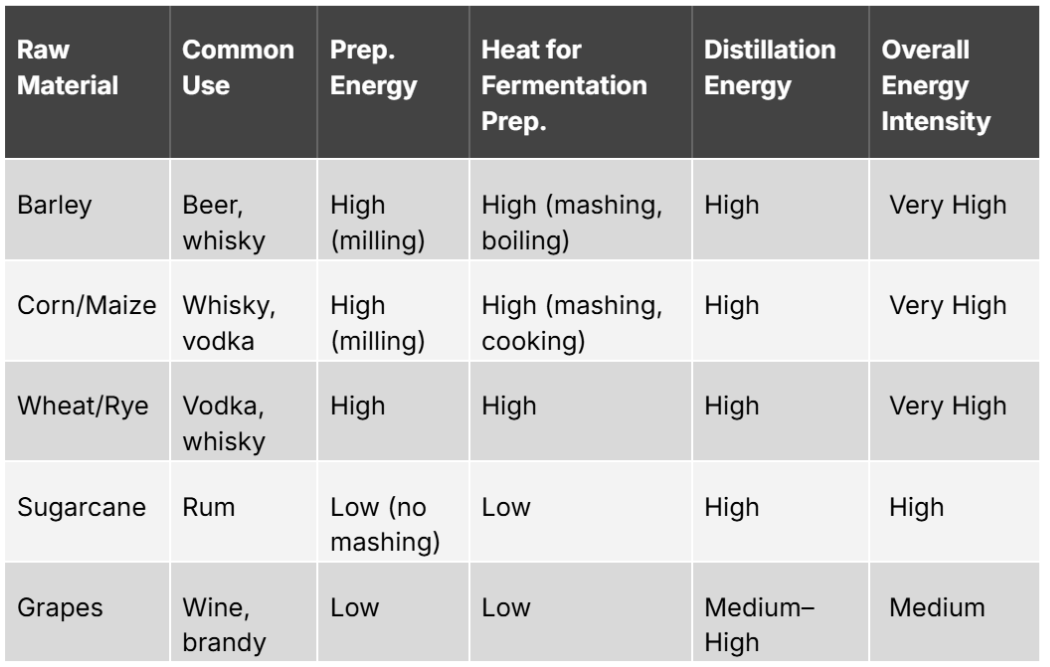
Steps of production and tackling distillation:
Grain based spirits such as whisky and vodka undergo mashing, fermentation, distillation, and aging, resulting in high energy use per liter.⁸ Beer, by contrast, involves other steps, making it compared to distilleries less energy intensive. Read more on the beer production and how Kraftblock helps breweries to decarbonize here. Wine, like beer, has no excludes distillation process and is therefore less relevant for high temperature heat considerations.
Production modes differ by category. Beer and wine are mainly batch processes, while spirits combine batch fermentation with either batch or continuous distillation.⁸ The reliance on distillation explains the higher energy demand in spirits. This is also the step with the highest temperatures, making distilleries a great user of thermal energy storage and electrification.
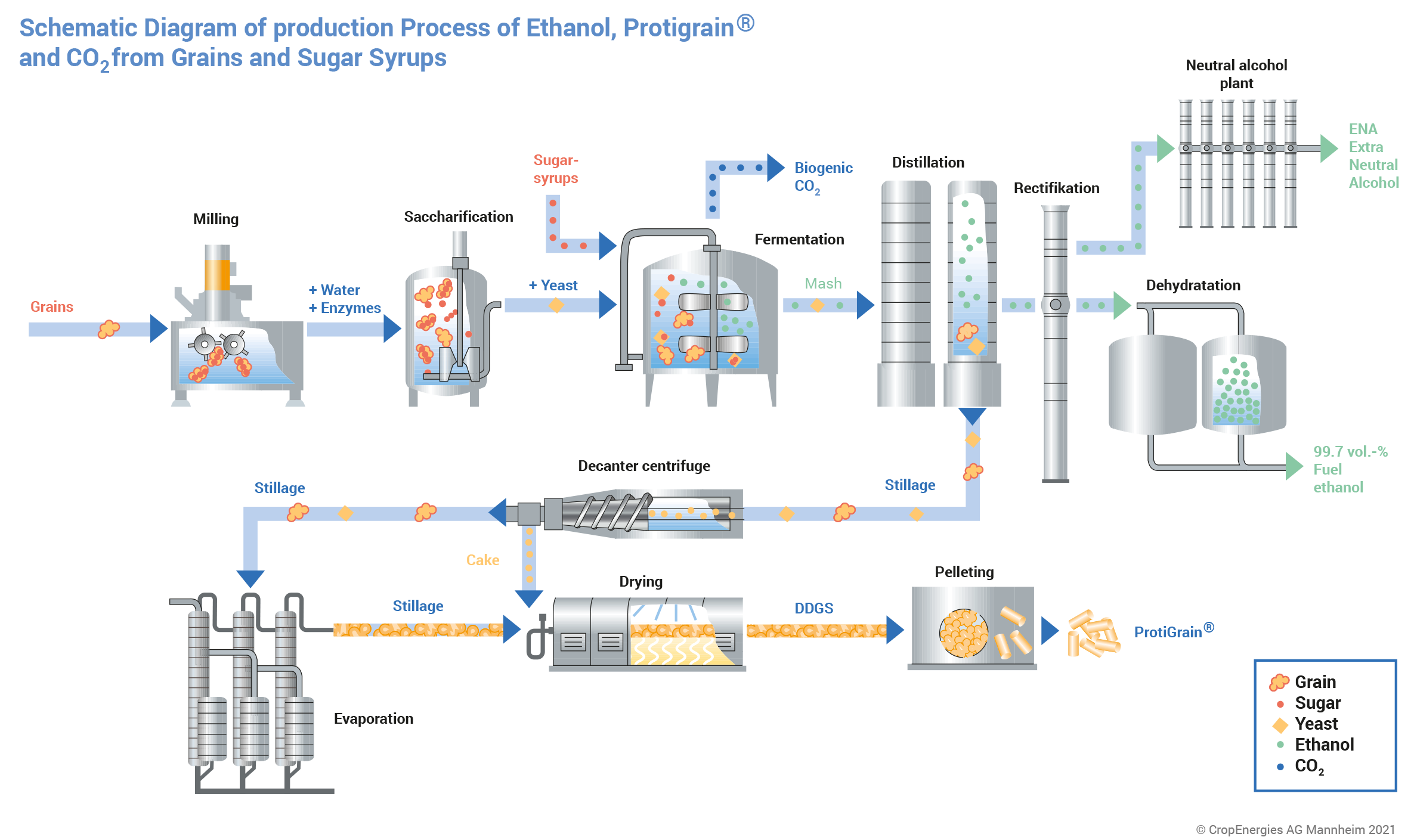
In beverage ethanol production, most heat demand comes from distillation, rectification, and dehydration.
- Distillation operates between 85–120 °C to separate ethanol from the mash
- Rectification refines purity at 78–105 °C under high reflux, especially for Extra Neutral Alcohol (ENA).
- Dehydration to fuel grade or ENA levels occurs at 80–100 °C with molecular sieves, or up to 130 °C with older extractive methods.
In neutral alcohol plants, these steps are combined across multiple columns, leading to high cumulative energy use.
Energy Use in Beverage Ethanol production
Distilled spirits are the most energy intensive product within the beverage ethanol sector. In Europe, the average energy use for producing spirits is reported to be around 3.45 kWh per litre of spirit.3 A detailed case study of a Scottish whisky distillery found that heat demand alone reached approximately 60 MJ per litre of alcohol (equivalent to about 17 kWhth/l). When accounting for additional operational energy requirements of a similar scale, the total energy demand rises to nearly 34 kWh/l.4 These figures underline the high energy burden of spirits, driven by multiple distillation steps, aging requirements, and packaging.
Benchmarking data for the broader beverage industry also reflects these differences. Average energy use across all beverage facilities declined from 0.70 MJ/L in 2017 to 0.62 MJ/L in 2022, an 11% efficiency improvement.5/6 Facility level results from 2022 show that breweries consumed about 0.48 MJ/l, wineries 0.55 MJ/l, and distilleries 0.73 MJ/l.6 This ranking confirms that distilleries are the most energy intensive on a per litre basis with breweries being the most efficient.
While fuel ethanol dominates in absolute production volume and total energy consumption, beverage ethanol especially distillation demands attention because of its exceptionally high unit energy demand. This makes the sector a prime candidate for targeted decarbonization measures, including integration of advanced heat storage and efficiency technologies.
Decarbonizing steam, the base of ethanol production
Ethanol is highly flammable, with a flash point of just 14 °C, meaning it can easily ignite at low temperatures when exposed to a spark or flame. For this reason, breweries and distilleries use indirect heating via water or steam rather than direct flames or hotplates, which ensures safe and controlled heating of ethanol containing mixtures.14
In beverage ethanol production, several heat-using steps are relevant.
- Pasteurization of beverages via heat exchangers usually operates in the range of 60–75 °C, depending on whether it’s a short time high temperature (flash) or longer-time lower temperature method to stabilize beverages, extend shelf life, and prevent bacterial growth.15
- Fermentation also requires thermal control: yeast metabolism generates heat, and maintaining stable temperatures is essential for ethanol yield and product quality¹⁶.
- These steps use relatively modest amounts of energy compared to distillation, which is done at up to 100 °C using steam networks carrying low-pressure steam of 120 °C or at up to 160 °C in continuous processes using networks with medium-pressure steam of up 180 °C.
Kraftblock systems can decarbonize steam networks in breweries and distilleries by replacing fossil boilers with thermal energy storage charged from renewable electricity or waste heat. They can supply steam at 120 °C for batch distillation and pasteurization as well as up to 180 °C for continuous distillation and rectification. This enables producers to keep existing process conditions while reducing fossil fuel use and integrating variable renewable energy.
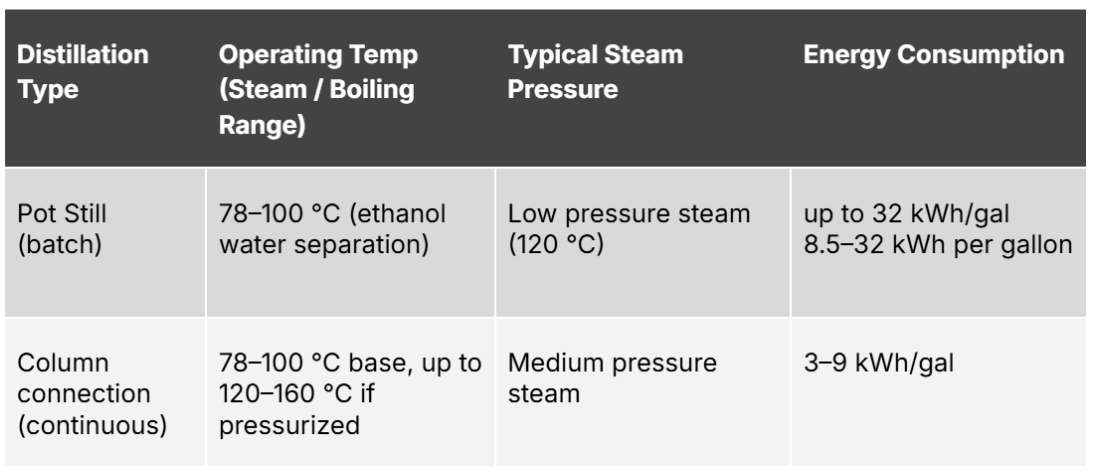
Distillation is not only the dominant energy user in beverage ethanol production (60–80% of total demand), but also highly inefficient: current processes require 5–8 MJ per liter ethanol, whereas the theoretical minimum is 1 MJ/L. This large performance gap makes distillation the most promising target for electrification and thermal energy storage integration. Pot stills can be retrofitted with electric steam generators or low temperature storage, while column stills may require higher temperature storage or high pressure electric boilers.
Breweries, while less energy intensive overall, still rely on steam for mashing, boiling, and pasteurization. Typical brewery systems operate with steam at 7–10 bar(g), corresponding to 170–180 °C.¹⁸ Distilleries likewise use boilers to supply both hot water and steam for heating. Larger column still operations often require higher-pressure steam, depending on design.¹⁹
In the broader ethanol industry, Distillers Grains (DDGS) drying (at up to 538 °C inlet gas temperatures) is the step with the highest temperature, often accounting for nearly 30% of total process energy.²⁰ However, DDGS drying is primarily associated with fuel ethanol production rather than beverages, and is therefore less relevant in this context.
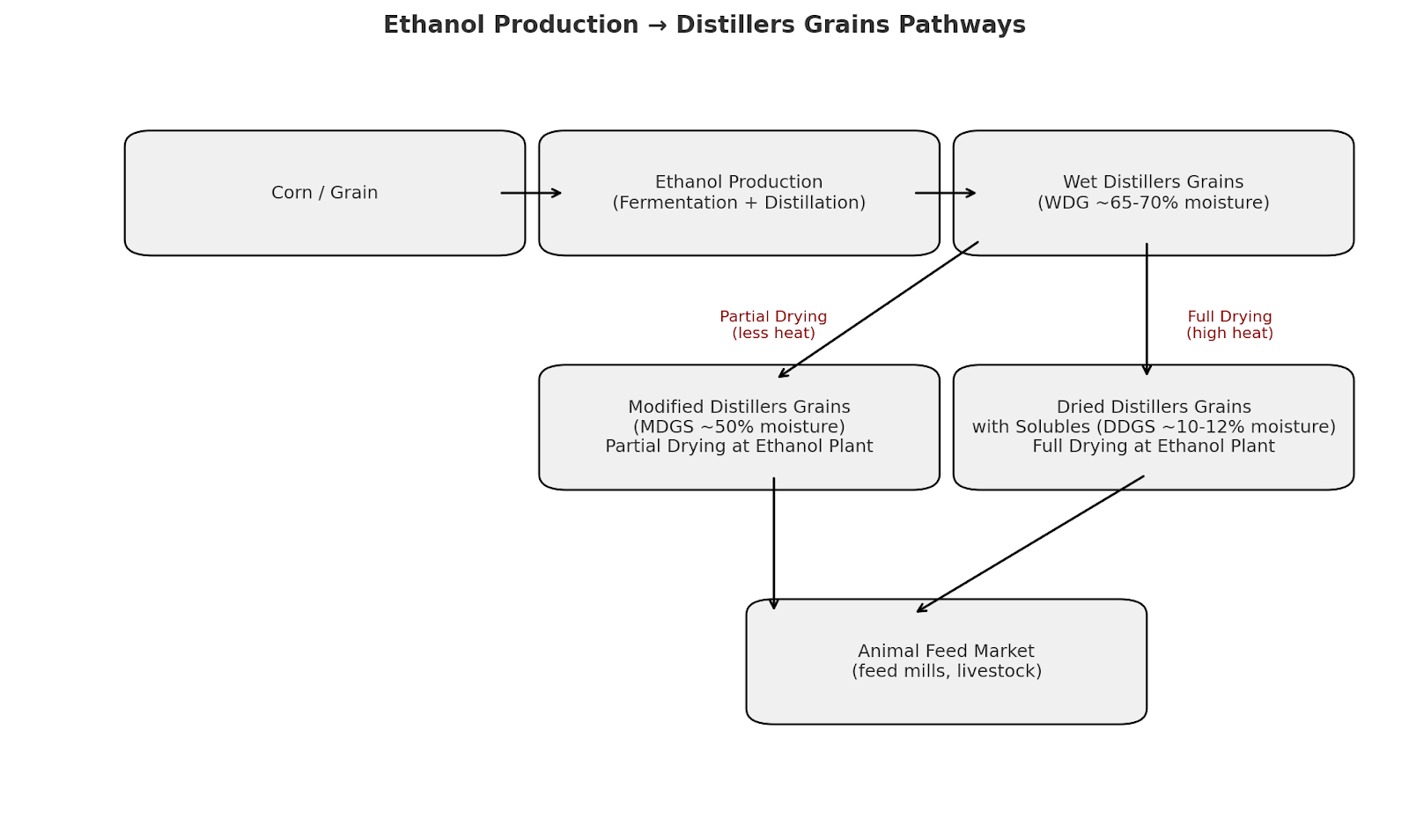
Summary: How to transition ethanol production sustainable
In conclusion, fermentation and pasteurization contribute to the energy balance of beverage ethanol but are relatively minor. Distillation especially in pot stills remains the critical hotspot, both in terms of heat demand and decarbonization potential. A compelling demonstration of this approach can be found in the PepsiCo Volt project in the Netherlands. Kraftblock’s system replaced a 25 MW gas fired boiler at a crisps plant, storing renewable electricity as heat (up to 800 °C) and supplying it on demand delivering up to a 98% reduction in CO₂ emissions from heat generation. This project is the first of its kind in Europe at an industrial scale and illustrates how the food and beverage industry can decarbonize process heat while maintaining production continuity.
For distilleries looking to decarbonize, this means that not just fuel ethanol beverage ethanol production can follow a similar path: integrating electric heat generation and high temperature thermal storage to phase out fossil fuels efficiently.
References
- ScienceDirect. Ethanol Production by Microorganisms
https://www.sciencedirect.com/science/article/abs/pii/S0065216418300194#:~:text=Ethanol%20Production%20by%20Microorganisms,and%20ATP%20production%20to%20continue. - IL-TEC. The Production of Ethyl Alcohol
https://il-tec.com/en/how-to-produce-alcohol/#:~:text=The%20Production%20of%20Ethyl%20Alcohol,into%20alcohol%20and%20carbon%20dioxide - SpiritsEUROPE. Farm to Glass Brochure (2020)
https://spirits.eu/upload/files/publications/CP.MI-165-2020-%20Farm2Glass%20Brochure%20-%2014%20May%2020 - ICREPQ Conference. Früh, W.-G. Energy Demand in Whisky Distilleries (2021)
https://icrepq.com/icrepq21/310-21-fruh.pdf?utm_source - U.S. Energy Information Administration (EIA). Biofuels Explained: Ethanol Supply
https://www.eia.gov/energyexplained/biofuels/ethanol-supply.php?utm_source - Beverage Industry Environmental Roundtable (BIER). 2023 Benchmarking Executive Summary Report
https://www.bieroundtable.com/wp-content/uploads/2023-BIER-Benchmarking-Executive-Summary-Report.pdf?utm_source - FIVS. Sustainability in the Wine and Spirits Sector
https://www.fivs.org/virtuallibrary/get/?cmdm_challenge=1476289394&cmdm_download_id=54519&cmdm_hash=7b8c36ba1aa2c70974410d238d02f6b8447f50ed&utm_source - Scotch Whisky Association. Scotch Whisky Production Process
https://www.scotch-whisky.org.uk/insights/scotch-whisky-production-process/ - Alcohol.org. The Alcohol Industry in Data
https://alcohol.org/guides/the-alcohol-industry-in-data/?utm_source - MicetCraft. Brewery Equipment List Options: A Deep Dive
https://www.micetcraft.com/brewery-equipment-list-options-a-deep-dive/?utm_source - Distil Equipment. Complete List of Equipment for a Distillery
https://distillequipment.com/complete-list-of-equipment-for-a-distillery/?utm_source - MicetCraft. Winery Machinery Guide: Essential Equipment, Costs & Buying Tips
https://www.micetcraft.com/winery-machinery-guide-essential-equipment-costs-buying-tips/?utm_source - CropEnergies. Ethanol Production Process – Zeitz Plant Scheme (2021)
https://www.cropenergies.com/fileadmin/Resources/CropEnergies/Files/Downloads/Produktinformationen/Schema_Zeitz_2021_eng_pdf.pdf - NIOSH. Pocket Guide to Chemical Hazards: Ethanol
https://www.cdc.gov/niosh/npg/npgd0262.html - AGC Heat Transfer. Value Heat Exchangers Bring to Beverage Production
https://www.agcheattransfer.com/blog/value-heat-exchangers-bring-to-beverage-production-process#:~:text=Beverage%20Pasteurization%20Process,pasteurization%20methods:%20standard%20and%20flash. - ResearchGate. Heat Generated During Ethanol Fermentation Using Thermotolerant Yeast
https://www.researchgate.net/figure/Heat-generated-during-ethanol-fermentation-using-thermotolerant-yeast-Kluyveromyces-sp_fig3_285604198 - U.S. EPA / ENERGY STAR. Energy Performance Indicator for Distilleries (Pot vs. Column Still Efficiency Data)
https://www.energystar.gov/industrial_plants/tools_resources/energy_performance_indicators/epi_tools/distilleries_epi - Clayton Industries. Industrial Steam Boilers for Brewing and Distilleries
https://www.claytonindustries.com/industrial-steam-boilers-for-brewing-and-distilleries/?utm_source - Beverage Master Magazine. Boilers in the Distillery: Gentle Giants That Pack a Punch
https://beverage-master.com/2019/10/boilers-in-the-distillery-gentle-giants-that-pack-a-punch/?utm_source - Louisville Dryer Company. Drying Distillers Grains
https://louisvilledryer.com/wp-content/uploads/2021/01/Drying-Distillers-Grains-HAND-OUT.pdf?utm_source - Eneco, Arup, Kraftblock. PepsiCo VOLT Thermal Storage Project (Netherlands)
https://www.kraftblock.com/projects
